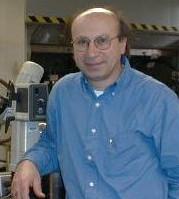Shahrokh Saba

Professor of Chemistry
Organic/Synthetic Chemistry
Email: [email protected]
Office: JMH 514
Lab: JMH 504
Phone: 718-817-4440
-
To develop operationally straightforward and synthetically useful methods for the preparation of nitrogen containing compounds using simple ammonium salts with nucleophilic and non-nucleophilic counterions as reagents. In connection with this theme we have developed one step protocols for the preparation of the following compounds: cyclic amidinium tetrafluoroborates and hexafluorophosphates; ternary and quaternary iminium tetrafluoroborates, hexafluorophosphates, and perchlorates; secondary and tertiary acetamides; alkyl-substituted amine tetrafluoroborate and hexafluorophosphate salts.
-
- Cyclic amidinium tetrafluoroborates and hexafluorophosphates by treating 1° or 2° diamines with ortho esters in the presence of ammonium tetrafluoroborate or hexafluorophosphate (Tetrahedron Lett. 1991, 32, 5031-5034)
- Ternary and quaternary iminium tetrafluoroborates, hexafluorophosphates, and perchlorates by direct treatment of aldehydes or ketones with 2° amines in the presence of the appropriate ammonium salt (J. Chem. Res. 2008, 301-304)
- Secondary as well as tertiary amines by direct heating an aldehyde or a ketone with an amine in the presence of ammonium formate (Tetrahedron Lett. 2011, 129-132)
- Alkyl-substituted amine tetrafluoroborate and hexafluorophosphate salts by direct heating of amine free bases with ammonium tetrafluoroborate or hexafluorophosphate (J. Fluorine Chem. 2013, 153, 168-171)
- Secondary and tertiary acetamides by converting amine free bases to their hydrochloride salts (by heating amine free bases with ammonium chloride) followed by treatment of the salts with trimethyl orthoacetate (Syn. Comm. 2015, 45, 2601-2607)
Develop discovery-based and pedagogically useful undergraduate organic laboratory experiments to illustrate important features related to molecular structure or chemical reactions. In connection with this theme we have developed the following organic chemistry laboratory experiments:
- Straightforward Synthesis and NMR Spectral Analysis of Amine Heterocycles: Discovering the Effect of Asymmetry on the 1H and 13C NMR Spectra of N,O-Acetals (J. Chem. Educ. 2007, 84, 1011-1013)
- Using NMR to Probe the Regio- and Stereochemistry of the Hydration of 1-Hexene, (J. Chem. Educ. 2010, 87, 1238-1241)
- NMR Determination of Enantiomeric Composition of Chiral Alcohols Using Camphorsulfonate Esters (Fordham Undergraduate Research Journal, 2011, 1, 1-3)
- Using NMR Spectroscopy to Probe the Chemo- and Diastereoselectivity in the NaBH4 Reduction of Benzoin Acetate and Benzoin Benzoate (J. Chem. Educ. 2015, 92(3), 543-547)
- Reaction of orthoesters with amine hydrochlorides: an introductory organic lab experiment combining synthesis, spectral analysis and mechanistic discovery (J. Chem. Educ. 2016, 93(5), 945-948)
- Probing the Reactivity of Cyclic N,O-Acetals versus Cyclic O,O-Acetals with NaBH4 and CH3MgI (J. Chem. Educ., 2018, 95 (6), 1045–1049)
- Synthesis and NMR-Spectral Analysis of Achiral O,O- and N,N-Acetals: Anisochronous pro-R and pro-S Ligands in NMR Spectra (J. Chem. Educ., 2019, 96, 354–359)
- Using NMR Spectroscopy and Chemical Synthesis to Establish Diastereoselectivity of NaBH4 and Meerwein−Ponndorf−Verley (MPV) Reduction of (±)-Benzoin Isopropyl Ether: A Collaborative Discovery-Based Laboratory Experiment (J. Chem. Educ. 2020, 97 (5), 1418−1424)
- Converting (±)-Benzoin to DL-Hydrobenzoin: A Pedagogically Valuable Collaborative Experiment Inspired by the Felkin-Anh Model for Nucleophilic Addition to α-Chiral Ketones (Chem. Educator 2023, 28, 26-31)
- Highly Reversed Diastereoselective Meerwein-Ponndorf-Verley (MPV) Reductions of Benzoin and Benzoin Pivalate Leading to meso- and DL-Hydrobenzoins: A Collaborative Stereochemical Investigation Using NMR Spectroscopy and Chemical Synthesis (J. Chem. Educ. 2024, 101 (1), 151-157)